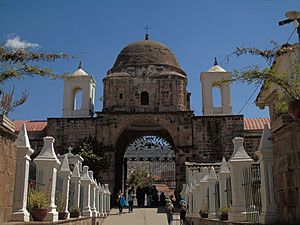Cementerio General de La Almudena facts for kids
 |
|
| Details | |
|---|---|
| Established | 1850 |
| Location | |
| Type | Public |
| Owned by | Sociedad de Beneficencia del Cusco |
The Cementerio General de La Almudena is a famous cemetery in Cuzco, Peru. It is located in the Plazoleta de la Almudena. This area also has the Almudena church and convent, which used to be a hospital. In the 1800s, there was also a hospital for people needing special care and a place where people were held in this area.
Today, besides the cemetery, the square has the Hogar Casa Acogida. This home helps young women. There is also the San Juan Pablo II Mental Health Hospital. Both are run by the Public Welfare Society of Cusco.
Since 2010, the Peruvian Ministry of Culture has called this cemetery a Cultural Heritage site. Also, in 1983, it became part of the historic center of Cuzco. This means UNESCO has listed it as a World Heritage Site.
Contents
History of the Cemetery
The cemetery was built between 1846 and 1850. This happened during the time Ramón Castilla was in charge of the government. He ordered a cemetery to be built in Cuzco for health reasons. Before this, since the time of the Spanish colony, people were buried in the basements of churches.
The city's leader, José Medina, chose the area for the cemetery. This spot was far from the city center. It was where the old Bethlehemites hospital and the Templo de la Almudena stood. A small colonial cemetery was already there, used by the hospital.
Building the Cemetery
To build the cemetery, materials from the Convent of San Agustín were used. This convent had been destroyed by cannon fire. This happened by order of Agustín Gamarra.
The front of the cemetery, facing the Plazoleta de la Almudena, is made of stone. It has neoclassical architecture with Greek columns. The main entrance has a round arch. It is flanked by double columns with fancy tops. Above the entrance, there is a round dome.
The front of the cemetery also has windows and doors on both sides. These lead to other rooms. These rooms were used for ceremonies and preparing bodies. These walls also saw important historical events in the 1800s.
Oldest Parts and Special Features
In the eastern part of the cemetery, you can find the oldest mausoleums. The oldest one is from 1857. We do not know who is buried there because the names have faded over time.
Close to this is the Cruz Mayor, or "Main Cross." This is common in old cemeteries in Peru. In this cemetery, the cross is carved. People who cannot find where their loved one is buried can leave offerings and prayers here.
Among the mausoleums, the one for the Mendivil family stands out. Its decorations show wise men and angel figures. These are made in the special Mendívil craft style, with long necks and tiny bodies.
In the same area is the Central Chapel of Santo Roma. This building is even older than the cemetery itself. It is located behind the Temple of the Almudena. It was built on January 27, 1802, by Bishop Bartolomé María de las Heras. This chapel first hosted burial ceremonies for the cemetery. Today, it is used for cremation.
Modern Changes and Unique Customs
Also in the eastern part, there is an exit from the cemetery. This exit was once used by people with less money. Since 2001, this area has been changed. Now, it has modern mausoleums and new sections.
One special thing about this cemetery is the use of gold and silver metals on the tombstones. This is different from other parts of Peru, where plaster or marble is more common. Also, families can decorate the tombstones with many small figures. This shows a lot about each family's unique traditions.
See also
 In Spanish: Cementerio General de La Almudena para niños
In Spanish: Cementerio General de La Almudena para niños

